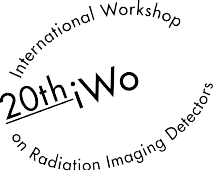Speakers
Description
Feasibility Evaluation of Mercury(Ⅱ) Iodide based Curved Dosimeter for measurement of Entrance Surface Dose in Radiotherapy
M.J. Han^a, Y.H. Shin^a, K.T. Kim^b, Y.J. Heo^c, K.M. Oh^d, D.H. Lee^c, J.Y. Kim^e, H.L. Cho^c, S.K. Park^c*
^aDepartment of Radiation Oncology, Collage of Medicine, Inje University
^bDepartment of Radiological science, International University of Korea
^cDepartment of Radiation Oncology, Haeundae Paik Hospital, Inje University
^dRadiation Equipment Research Division Korea Atomic Energy Research Institute
^eDepartment of Radiation Oncology, Busan Paik Hospital, Inje University
Today, in the radiotherapy for skin, the criticality of skin dose detection is increasing to prevent unnecessary exposures. For the phase of skin coordination to prevent the accumulating skin dose during treatment, Glass Rod Dosimeter(GRD) and Optically Stimulated Luminescent Dosimeter (OSLD) are the representative applications while the point measurement that reads by attaching many dosimeters is utilized. However, in clinics, the complexity and the time consumption in reading on the integrating analog detection are pointed as issues. Also, the inaccuracy of the dosimeter attachment point visually determined on the local area leads the difficulty of accurate dose analysis. ^[1-2] In the meanwhile, a photoconductor HgI_2 shows advantages beneficial for minimization since its actual atomic number and density are higher than those of GRD or OSLD. Also, the photoconductor in powder form, when mixed with a polymer binder, makes production if an array dosimeter in a curved structure. ^[3] Therefore, in this study, as a basic research to develop a real-time skin dose monitoring technology for the computerized treatment system, a unit cell dosimeter and a film based line type array dosimeter are produced. The unit cell dosimeter is produced in the size of 1 x 1 cm^2 with the thickness of 150 μm utilizing the Particle In Binder evaporation method and evaluated on its reproducibility and linearity to verify the performance. For the reproducibility, the same dose amount of 100 MU with the dose rate of 500 MU/min is examined 10 times. Then, Standard Errors(SE) are calculated on all the acquired measurements and evaluated based on the number less than 1.5% satisfying the 95% confidence interval. For the linearity, against the dose rates of 100 to 600 MU/min, the dose is gradually increased from 1 MU to 1,000 MU. Then, the measured data is evaluated based on the determination coefficient given from the linear regression analysis. Later, to verify the applicability of curve measurement, a 7-Pixel Line Array Dosimeter showing the pixel size of 1 x 1 cm^2 and the pixel pitch of 3 cm is produced. The irradiation condition of the line array sensor is the 10 irradiations of the dose of 100 MU with the dose rate of 500 MU/min. To present the dose distribution exposed to the skin, the average error rate is acquired from the dose distribution measured from the 4 pixels located at the iso-centers of the flat and curved circuit board (Radius: 20.5 cm). According to the results of this trial, the reproducibility evaluation of the unit cell dosimeter shows that the cases of 6 MV and 15 MV are 0.613% and 1.465% respectively to be in the 1.5% confidence interval. According to the linearity evaluation, the R-sq values of 6 MV and 15 MV are 0.9999 and 0.9981 respectively showing superb linearity close of the determination coefficient of 1. The line array dosimeter produced based on these results shows the average error rates are 23.337% and 12.264% with 6 MV on the flat and curved area respectively while being 11.691% and 8.372% with 15 MV. Then, the curved area measurements show reduced error rates reduced 11.073%p with 6 MV and 3.318%p with 15 MV from the cases of flat area demonstrating its applicability. Therefore, if additional studies are performed on the dose distribution by the photon energy, the application of curved dosimeter would become possible to analyze the dose distribution on the geometrical structure of human body.
[1] W. J. Yoo et al., Measurement of Entrance Surface Dose on an Anthropomorphic Thorax Phantom Using a Miniature Fiber-Optic Dosimeter, 2014 Sensors 14, 6305-6316.
[2] McCabe, B.P. et al., Calibration of GafChromic XR-RV3 radiochromic film for skin dose measurement using standardized x-ray spectra and a commercial flatbed scanner, 2011 Med. Phys 38, 1919–1930.
[3] K. M. Oh et al., Flexible X-ray Detector for Automatic Exposure Control in Digital Radiography, 2016 JNN 16, 11473-11476.
